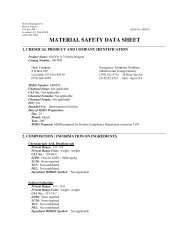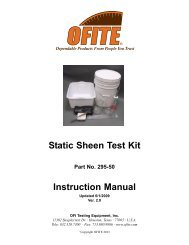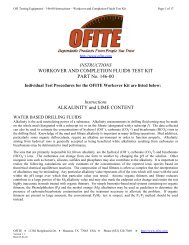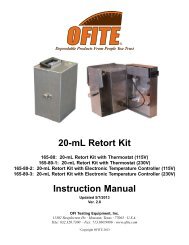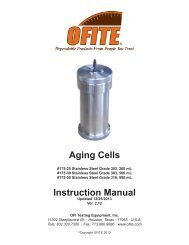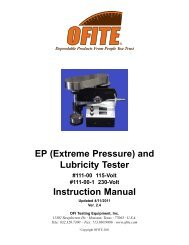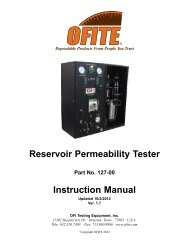Chloride and Alkalinity Test Kit - OFI Testing Equipment, Inc.
Chloride and Alkalinity Test Kit - OFI Testing Equipment, Inc.
Chloride and Alkalinity Test Kit - OFI Testing Equipment, Inc.
Create successful ePaper yourself
Turn your PDF publications into a flip-book with our unique Google optimized e-Paper software.
<strong>OFI</strong> <strong>Test</strong>ing <strong>Equipment</strong> – 144-50 Instructions – <strong>Chloride</strong> <strong>and</strong> <strong>Alkalinity</strong> Determination Page 1 of 6<br />
http://www.ofite.com<br />
INSTRUCTIONS<br />
CHLORIDE & ALKALINITY DETERMINATION<br />
<strong>OFI</strong>TE PART No. 144-50<br />
<strong>OFI</strong>TE • 11302 Steeplecrest Dr. • Houston, TX 77065 USA • Phone (832) 320-7300 • http://www.ofite.com<br />
Version 1.1<br />
Date 02-27-03
<strong>OFI</strong> <strong>Test</strong>ing <strong>Equipment</strong> – 144-50 Instructions – <strong>Chloride</strong> <strong>and</strong> <strong>Alkalinity</strong> Determination Page 2 of 6<br />
EQUIPMENT:<br />
QUANTITY DESCRIPTION PART NO.<br />
1 Titration Dish, Polyethylene 153-26<br />
2 Stirring Rod, Polyethylene 153-28<br />
2 1 ml Pipette 153-40<br />
2 10 ml Pipette 153-40<br />
2 Distilled Water, 16 FL. OZ. 206-02<br />
1 Pot Chromate Ind Soln 2 FL. OZ. 215-00<br />
1 Phenolphthalein Ind Soln. 2 FL. OZ. 220-00<br />
1 N/50 Sulfuric Acid, 8 FL. OZ. 230-08<br />
1 Brom Cresol Green-Methyl Red (Ind Soln, 2 FL. OZ) 245-00<br />
1 0.0282N Silver Nitrate, 8 FL. OZ. 265-00<br />
1 0.28N Silver Nitrate, 8 FL. OZ. 265-06<br />
CHLORIDE ION DETERMINATION:<br />
This test measures the soluble chloride Ion concentration in the mud filtrate. The <strong>Chloride</strong> can come from sodium<br />
chloride, calcium chloride or potassium chloride. Also, for the titration to work correctly the pH of the filtrate needs to<br />
be only weakly basic (pH = 8.3). This is the reason for the first step in the procedure. There are two chemical reactions<br />
taking place simultaneously during the titration:<br />
1. Ag (+) + Cl ----------AgCL<br />
2. 2 Ag (+) + CrO4 ----Ag2CrO4<br />
The first reaction, the formation of silver chloride, accounts for the appearance of the white specs or milky appearance<br />
during the titration. The formation of the silver chromate, which is red, will not start until all the chloride Ions are tied<br />
up as silver chloride. The silver nitrate will then react with the chromate from the potassium chromate indicator to form<br />
silver chromate. So, for the above two reactions to occur, the filtrate needs to be weakly basic (pH = 8.3). High pH will<br />
precipitate silver oxide.<br />
<strong>OFI</strong>TE • 11302 Steeplecrest Dr. • Houston, TX 77065 USA • Phone (832) 320-7300 • http://www.ofite.com<br />
Version 1.1<br />
Date 02-27-03
<strong>OFI</strong> <strong>Test</strong>ing <strong>Equipment</strong> – 144-50 Instructions – <strong>Chloride</strong> <strong>and</strong> <strong>Alkalinity</strong> Determination Page 3 of 6<br />
PROCEDURE:<br />
1. Pipette 1.0 ml of filtrate or sample to be tested into titration dish.<br />
2. Add 2 – 3 drops of phenolphtahalein indicator to the filtrate.<br />
3. If a pink color appears, titrate with N/50 sulfuric acid until the color changes from pink to that of the<br />
original sample. If no pink color appears, the test can be continued.<br />
4. If needed, add 25 – 50 mls of distilled water. This serves to dilute the dark color of a deeply colored filtrate.<br />
It does not influence the test in any way if there are no chlorides present in the distilled water. If any water<br />
other than distilled water is used, the chloride in it must be accounted for by titration before adding the<br />
filtrate to it.<br />
5. Add 10 – 15 drops of potassium chromate indicator to give the filtrate a bright yellow color.<br />
6. Add silver nitrate from a pipette dropwise, stirring continuously with a stirring rod, until the sample just<br />
turns from yellow to an orange-red.<br />
CALCULATION:<br />
1. Parts per million (ppm) chloride = mls of silver nitrate used x 1,000 (If 0.0282N Silver Nitrate, lml = 1,000<br />
ppm Cl is used)<br />
2. Parts per million (ppm) chloride = mls of silver nitrate used x 10,000 (If 0.28N Silver Nitrate, lml = 10,000<br />
ppm Cl is used)<br />
3. ppm (NaCl) = ppm <strong>Chloride</strong> x 1.65<br />
REMARKS:<br />
1. The chloride test may be run on the same samples used in the Pf determination if the Mf test was not<br />
performed.<br />
2. Avoid contact with silver nitrate. Wash immediately with water if silver nitrate gets on skin or clothing.<br />
3. The end point of the reaction is when the silver chromate is first formed. It is reddish in color. When using<br />
the weak silver nitrate, the end point is approached very gradually. Therefore, the formation of the silver<br />
nitrate can be seen by a color change from yellow to orange-red. If the strong silver nitrate is used, the end<br />
point is approached much more rapidly. Hence the early formation of the silver chromate <strong>and</strong> its orange-red<br />
color may be missed due to the larger amounts of silver nitrate being added. So the color change will go<br />
from yellow to red, as soon as the red color is seen, the titration is complete.<br />
4. White lumps of silver chloride form when titrating high concentrations of salt. This should not be taken for<br />
the end point.<br />
5. If the chloride Ion concentration is less than about 10,000 ppm, the weak silver nitrate solution should be<br />
used. If it is greater than 10,000, the strong silver nitrate solution should be used.<br />
<strong>OFI</strong>TE • 11302 Steeplecrest Dr. • Houston, TX 77065 USA • Phone (832) 320-7300 • http://www.ofite.com<br />
Version 1.1<br />
Date 02-27-03
<strong>OFI</strong> <strong>Test</strong>ing <strong>Equipment</strong> – 144-50 Instructions – <strong>Chloride</strong> <strong>and</strong> <strong>Alkalinity</strong> Determination Page 4 of 6<br />
ALKALINITY DETERMINATIONS:<br />
I. MUD ALKALINITY (Pm)<br />
This test measures the alkalinity of the whole mud. When used along with the filtrate alkalinity<br />
determination, the amount of excess line present in lime muds can be determined.<br />
PROCEDURE:<br />
1. Measure 1 ml of a freshly stirred sample of mud into a titration dish using a syringe.<br />
2. The syringe should have a capacity of at least 3 mls. Draw at least two mls <strong>and</strong> preferably three mls of mud<br />
into the syringe. Remove any air bubbles from the sample. Then inject a one ml sample by pushing the<br />
plunger from the 3 ml graduation to the 2 ml graduation or the 2 ml graduation to the 1 ml graduation, but<br />
never from 1 ml to the bottom of the syringe.<br />
3. Dilute the mud in the dish with 25 – 50 mls of distilled water.<br />
4. Add no more than 4 or 5 drops of phenolphthalein.<br />
5. If the sample does not change color, report the Pm as 0.<br />
6. If the sample turns pink, titrate rapidly with N/50 sulfuric acid until the pink color disappears.<br />
CALCULATIONS:<br />
Report the phenolphthalein alkalinity of the mud, (Pm) as the number of mls of N/50 sulfuric acid added to discharge all<br />
the pink color.<br />
REMARKS:<br />
1. If the mud sample is deeply colored from chemical thinners <strong>and</strong> the color change is hard to see, use ½ ml of<br />
mud <strong>and</strong> report the Pm as the volume of N/50 sulfuric acid added to discharge the pink color doubled.<br />
2. If 0.1N sulfuric acid is used, the Pm is reported as volume of N/50 sulfuric acid added to 1 ml of mud<br />
times 5.<br />
II.<br />
FILTRATE ALKALINITY (Pf, Mf):<br />
<strong>OFI</strong>TE • 11302 Steeplecrest Dr. • Houston, TX 77065 USA • Phone (832) 320-7300 • http://www.ofite.com<br />
Version 1.1<br />
Date 02-27-03
<strong>OFI</strong> <strong>Test</strong>ing <strong>Equipment</strong> – 144-50 Instructions – <strong>Chloride</strong> <strong>and</strong> <strong>Alkalinity</strong> Determination Page 5 of 6<br />
These tests are designed to measure the alkalinity contributions from soluble mud constituents. The<br />
Pf <strong>and</strong> Mf test together can be used to get an estimate of the hydroxide Ion (OH-), the bicarbonate<br />
Ion (HCO3-) <strong>and</strong> the carbonate Ion (CO3 –2) concentration. Also the Pf can be used with the Pm to<br />
determine the excess amount of lime present in a lime base mud.<br />
PROCEDURE (Pf)<br />
1. Pipette 1 ml of filtrate into a clean titration dish. (Do not dilute with distilled water.)<br />
2. Add more than 2 – 3 drops of Phenolphthalein. If no color develops, the Pf is 0 (<strong>and</strong> pH is less than 8.3). If<br />
a pink color develops, add N/50 sulfuric acid through a pipette until the color changes pink to that of the<br />
original sample.<br />
CALCULATIONS (Pf)<br />
1. The Pf is the amount of N/50 sulfuric acid required to discharge the pink color.<br />
2. Excess lime content, lb/bbl = Pm – Pf<br />
4<br />
PROCEDURE (Mf)<br />
1. To the same sample used for the Pf determination, add 2 –3 drops of Brom cresol green-methyl red<br />
indicator.<br />
2. Again add N/50 sulfuric acid until the color changes from a blue-green to a light pink color.<br />
CALCULATIONS (Mf)<br />
1. Report the Mf alkalinity of the filtrate as the total volume of N/50 sulfuric acid required to reach the end point,<br />
including the volume required to reach the Pf end point.<br />
2. An estimation of hydroxide Ion, bicarbonate Ion <strong>and</strong> carbonate Ion concentrations can be determined using the<br />
following table.<br />
CALCULATIONS OF ALKALINITY:<br />
<strong>Test</strong> Results<br />
Calculations<br />
<strong>OFI</strong>TE • 11302 Steeplecrest Dr. • Houston, TX 77065 USA • Phone (832) 320-7300 • http://www.ofite.com<br />
Version 1.1<br />
Date 02-27-03
<strong>OFI</strong> <strong>Test</strong>ing <strong>Equipment</strong> – 144-50 Instructions – <strong>Chloride</strong> <strong>and</strong> <strong>Alkalinity</strong> Determination Page 6 of 6<br />
Where Pf = Mf<br />
(indicates OH only)<br />
Where 2 Pf-Mf is a positive number<br />
(indicates OH- & CO3-2)<br />
Where 2 Pf = M<br />
(indicates CO3-2 only)<br />
Where 2Pf-Mf is a negative number<br />
(indicates CO3-2 & HCO3-)<br />
Where no Pf reading or very low Pf<br />
(indicates HCO3 – only)<br />
Pf x 340 = Mg/L OH-<br />
(2pf-Mf) x 340 = Mg/L OH-<br />
2(mf-Pf) x 600 = Mg/L CO3-2<br />
Mf x 600 = Mg/L CO3-2<br />
2 Pf x 600 = Mg/L co3-2<br />
(Mf-2Pf) x 1220 = Mg/L HCO3-<br />
Mf x 1220 = Mg/L HCO3-<br />
NOMENCLATURE:<br />
Pf = Pnenolphtbalein end point of the filtrate sample using N/50 sulfuric acid<br />
Mf = Methyl Orange or Brom Cresol Green-Methy red end point of filtrate sample using N/50 Sulfuric Acid<br />
OH = Hydroxide Ion<br />
CO3-2 = Carbonate Ion<br />
HCO3- = Bicarbonate Ion<br />
<strong>OFI</strong>TE • 11302 Steeplecrest Dr. • Houston, TX 77065 USA • Phone (832) 320-7300 • http://www.ofite.com<br />
Version 1.1<br />
Date 02-27-03



